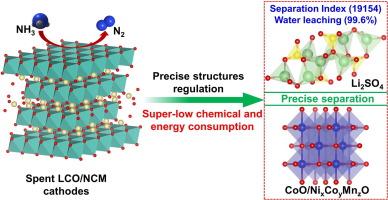Precise regulation of layered-to-rock structure of spent Li-ion cathodes achieving ultrahigh lithium recovery rate
IF 13.3
1区 工程技术
Q1 ENGINEERING, CHEMICAL
引用次数: 0
Abstract
With the rapid development of electric vehicles and digital devices, the accumulated spent lithium-ion batteries (LIBs) cause severe anxiety about lithium resources and environmental safety. However, the low capture rate of Li+ and the high chemical consumption of the existing recovery methods lead to high Li loss, treatment costs and disposal fees. Herein, we propose a universal strategy of spent LIBs recovery via precise directional regulating structures (from layered to rock) to achieve ultrahigh lithium recovery rate with super-low chemical and energy consumption. Experimental characterization and theoretical calculations reveal the dissociation of structure, reorganization of Li–O bonds and phase transformation of the cathode materials in the limited-domain reduction process, realizing the complete recovery of Li+ without consuming acid leaching agent. This process realizes an extra-high Li separation index (19154) and extra-long cycle half-life (173 cycles) which are far superior to those of traditional methods (9–191 and 7 cycles). Besides, ecological and economic analysis shows that the consumptions of chemicals and energy are only 9 % and 9.7 % those of the existing literature, respectively, providing a bright pathway for industrializable lithium batteries recycling.

精确调节废锂离子正极的层岩结构,实现超高锂回收率
随着电动汽车和数码设备的快速发展,累积的废旧锂离子电池(LIB)引起了人们对锂资源和环境安全的严重担忧。然而,现有回收方法对 Li+ 的捕获率低、化学药剂消耗量大,导致锂损耗高、处理成本高、处置费用高。在此,我们提出了一种通过精确定向调节结构(从层状到岩状)回收废锂电池的通用策略,以超低的化学和能源消耗实现超高的锂回收率。实验表征和理论计算揭示了限域还原过程中正极材料的结构解离、锂-O 键重组和相变,在不消耗酸浸出剂的情况下实现了 Li+ 的完全回收。该工艺实现了超高的锂分离指数(19154)和超长的循环半衰期(173 次),远远优于传统方法(9-191 次和 7 次)。此外,生态和经济分析表明,该工艺的化学品和能源消耗分别仅为现有文献的 9% 和 9.7%,为锂电池回收的工业化提供了一条光明大道。
本文章由计算机程序翻译,如有差异,请以英文原文为准。
求助全文
约1分钟内获得全文
求助全文
来源期刊

Chemical Engineering Journal
工程技术-工程:化工
CiteScore
21.70
自引率
9.30%
发文量
6781
审稿时长
2.4 months
期刊介绍:
The Chemical Engineering Journal is an international research journal that invites contributions of original and novel fundamental research. It aims to provide an international platform for presenting original fundamental research, interpretative reviews, and discussions on new developments in chemical engineering. The journal welcomes papers that describe novel theory and its practical application, as well as those that demonstrate the transfer of techniques from other disciplines. It also welcomes reports on carefully conducted experimental work that is soundly interpreted. The main focus of the journal is on original and rigorous research results that have broad significance. The Catalysis section within the Chemical Engineering Journal focuses specifically on Experimental and Theoretical studies in the fields of heterogeneous catalysis, molecular catalysis, and biocatalysis. These studies have industrial impact on various sectors such as chemicals, energy, materials, foods, healthcare, and environmental protection.
文献相关原料
公司名称
产品信息
阿拉丁
(NH4)2SO4
 求助内容:
求助内容: 应助结果提醒方式:
应助结果提醒方式:


